IS IT FOR KIDS?

Attention all mommies
daddies! Are you ready to discover a game-changing tool that will revolutionize your child's learning experience?


Allow us to introduce you to the Montessori Board!
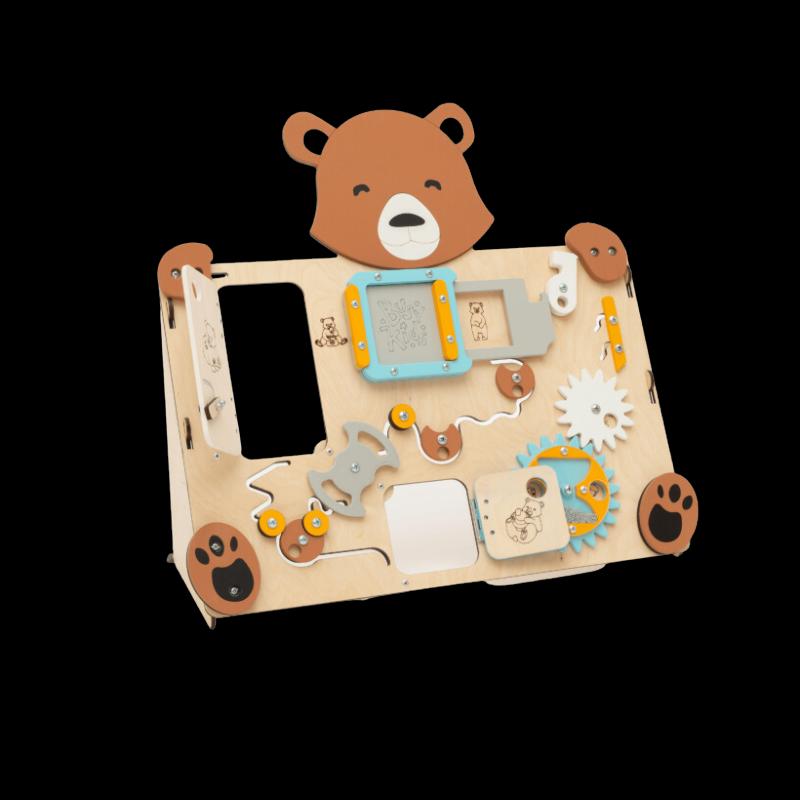


Attention all mommies
daddies! Are you ready to discover a game-changing tool that will revolutionize your child's learning experience?


Allow us to introduce you to the Montessori Board!

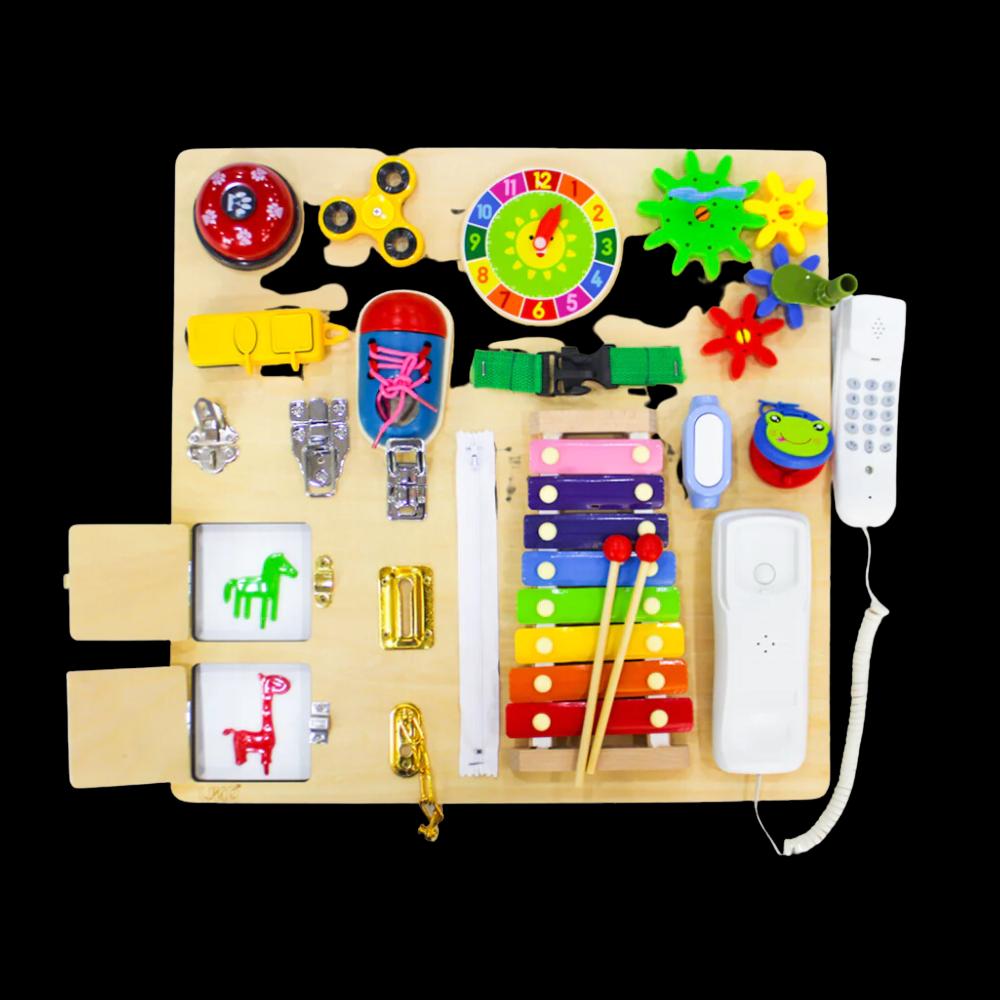
A Montessori Busy Board is a sensory and educational tool and toy that is particularly developed for children between the ages of 1 and 4 years old(Davies, 2023). Children at this age are rapidly acquiring fine motor abilities and investigating their surroundings(NAEYC, n.d.). The Montessori Busy Board is designed to give age-appropriate challenges and activities that develop problem-solving and independence.

Children may improve their hand-eye coordination, dexterity, and cognitive abilities by interacting with the numerous features on the board, such as locks, latches, buttons, zippers, and manipulative items (Ministry of Education, 2021). They can control the various components, working out riddles, opening and closing locks, and acquiring fundamental skills like buttoning or zipping.
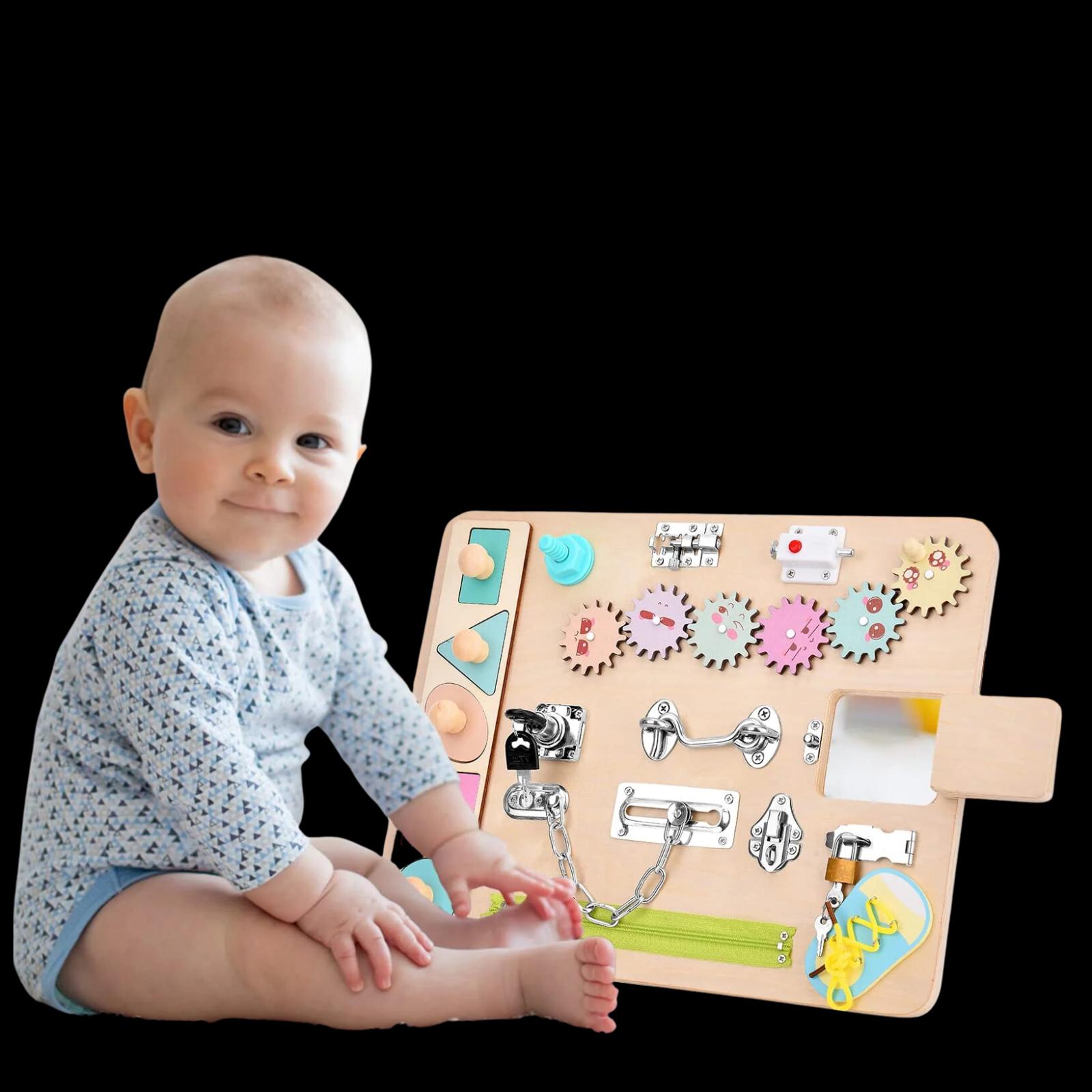
The Montessori Busy Board encourages autonomous play by enabling children to investigate and explore at their own speed (Cerri, 2022). It promotes self-directed learning by allowing students to identify cause-and-effect links and problem-solving solutions. The board provides a pleasant and safe setting for children in early childhood to learn and develop important skills.
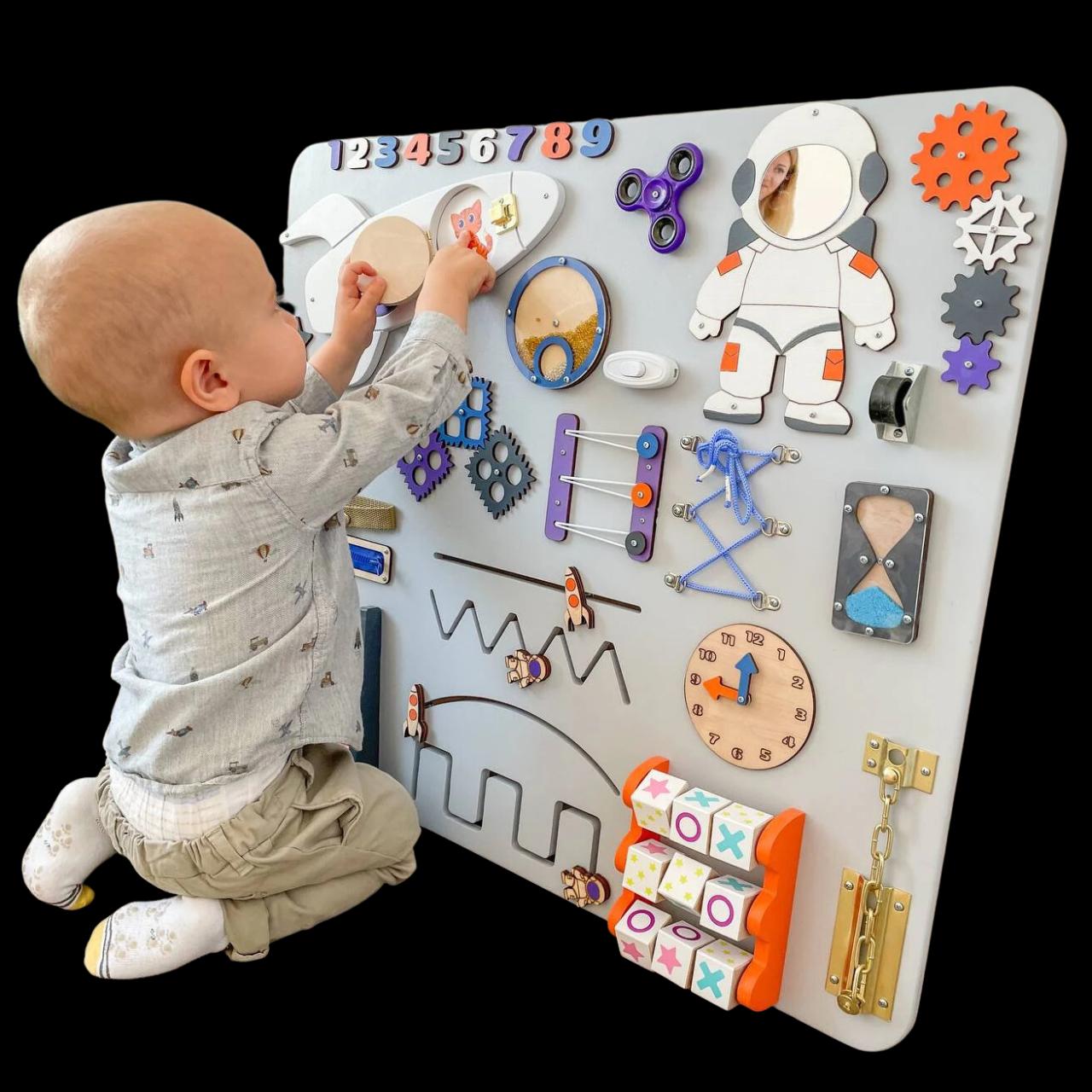
ABOUT THE THEORY
Piaget's Theory of Cognitive Development is a comprehensive framework that explains how children construct knowledge and develop their cognitive abilities. The theory emphasizes that children actively engage with their environment, assimilate new information, and accommodate their existing schemas to incorporate new knowledge.
2 ASSIMILATION & SCHEMA
Busy board components introduce new sensory experiences and challenges. The busy board challenges children to assimilate the new experiences into their mental frameworks and Through assimilation, children actively construct their understanding of the world by fitting new information into their pre-existing mental frameworks.
ASSIMILATION & SCHEMA
Montessori busy board tool provides sensory-rich experiences for children to interact with and The busy board challenges children to assimilate the new experiences into their mental frameworks For example, when a child encounters a new type of latch or button on the board, they assimilate it into their understanding of how latches or buttons work.
MONTESSORI BUSY BOARDS SEEN IN EACH COGNITIVE DEVELOPMENT STAGE
SENSORIMOTOR STAGE (BIRTH TO 2 YEARS):
Infants are exploring the environment through their senses and motor skills at this period. Montessori busy boards can provide sensory stimulation as well as possibilities for fine motor skill development. Busy boards with varying textures, buttons to press, zippers to open and shut, and knobs to spin may keep newborns entertained and help them finetune their motor skills.
PREOPERATIONAL STAGE (2 TO 7 YEARS):
Children participate in symbolic play and improve their linguistic abilities throughout this time Activities that enhance imaginative play and language development can be included on Montessori busy boards. A busy board, for example, with miniatures of daily things like a phone, keys, or a clock, might foster pretend play and linguistic expression
CONCRETE OPERATIONAL STAGE (7 TO 11 YEARS):
Children at this period gain logical thinking skills and are able to think more creatively. Montessori busy boards can be constructed to test children's problem-solving abilities and promote logical thinking. For this age range, boards with puzzles, mazes, and locks that involve sequential thinking and planning can be beneficial.
(11
In this stage, Children acquire abstract thinking and can participate in hypothetical reasoning during this period Montessori busy boards can be used to encourage creativity and critical thinking. Building, construction, and experimenting boards can give opportunity for students to explore abstract topics and improve problem-solving abilities
VYGOTSKY’S SOCIOCULTURAL THEORY & MONTESSORI BOARDS
1
ZONE OF PROXIMAL DEVELOPMENT
tasks too difficult for children to learn alone but can master with assistance
3
Vygotsky’s theories stress the fundamental role of social interaction in the development of cognition (Vygotsky, 1978), as he believed strongly that community plays a central role in the process of “making meaning."
2
adjusting the level of support based on the child's performance
4
Vygotsky stated that language has two functions. Inner speech is used for mental reasoning and external speech is used to converse with others. These operations occur separately Indeed, before the age of two, a child employs words socially; they possess no internal language Once thought and language merge, however, the social language is internalized and assists the child with their reasoning. Thus, the social environment is ingrained within the child’s learning.
The Montessori board functions as a tool that provides structured learning experiences. Similar to Vygotsky's concept of scaffolding, it offers temporary support and guidance to assist children in completing tasks that surpass their current independent capabilities. By gradually increasing the complexity of activities, the Montessori board presents challenges that align with the child's Zone of Proximal Development (ZPD). As the child advances, they can autonomously tackle more advanced tasks on the board, fostering cognitive growth and mastery
Badura (1977) claims that "most human behavior is learned observationally through modeling: from observing others one forms an idea of how new behaviors are performed, and on later occasions, this coded information serves as a guide for action."
Bandura's Social Learning Theory emphasizes the role of social interactions in the learning process According to Bandura, individuals learn not only through direct experience but also by observing and imitating others This theory highlights the significance of modeling, where individuals learn behaviors by observing others and then imitating them.
Montessori boards can provide a platform for social interactions and modeling within the Montessori learning environment When children engage with the boards together, they have the opportunity to observe and learn from one another For example, if one kid successfully completes a work on the Montessori board, other children can observe and mimic the action, allowing them to learn and acquire new abilities via observation and modeling.
There is a 3-step process in Social Learning Theory (Nabavi, 2012):
-We observe the behavior of other people around us
Imitation
-We assimilate and imitate the behavior we observed
We are more likely to imitate the behavior of people we perceive as similar to ourselves Three basic model types:
Live model - A person is observed acting out the behavior
Verbal instruction model - Behavior is described
Symbolic model - A character displays a certain behavior through media (TV, books, etc )
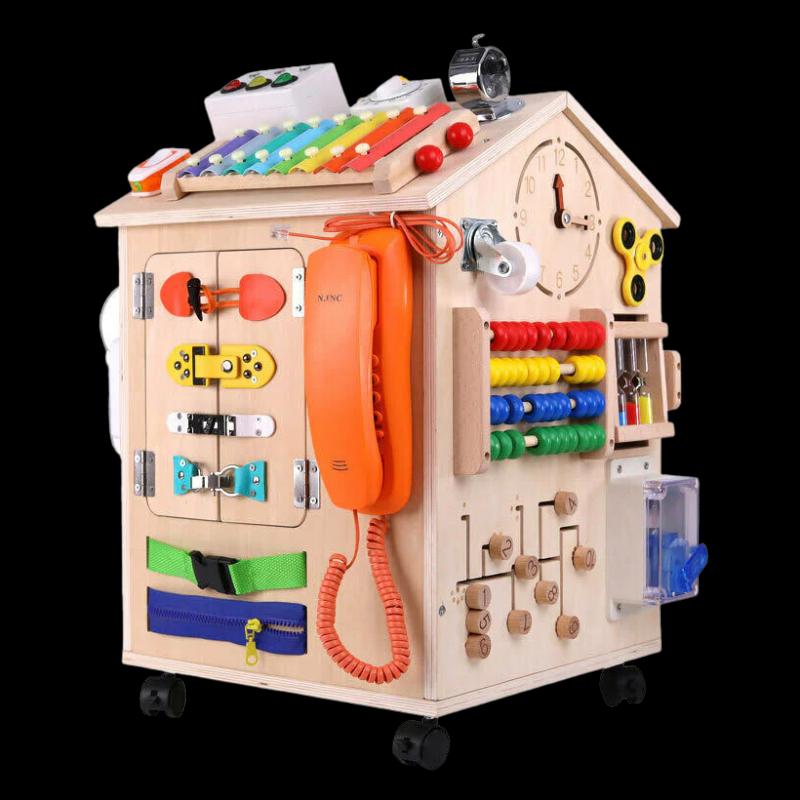
Bowlby's Attachment Theory explains the significant emotional bond that forms between a child and their primary caregiver, which is crucial for the child's healthy development and provides a secure foundation for exploring the world(Hong & Park, 2012). Montessori boards, commonly used in Montessori schools, can be seen as complementary to Attachment Theory due to their repetitive and predictable nature. These boards offer infants a sense of familiarity and predictability, promoting a feeling of mastery as they complete tasks(Isaacs, 2018).
The Montessori philosophy emphasizes the importance of allowing children to choose their own activities, which contributes to their sense of control and security in learning. Although busy boards are designed to encourage independent exploration, caregivers can actively participate during playtime, fostering the attachment bond. Caregivers engaging with the child's exploration by offering encouragement, guidance, and praise further strengthens the attachment relationship.
Montessori busy boards align with Attachment Theory's emphasis on active exploration and learning. By engaging in hands-on play, children can explore textures, shapes, colors, and problem-solving challenges, fostering cognitive development and curiosity. The caregiver's supportive presence during this exploration further strengthens the attachment relationship.
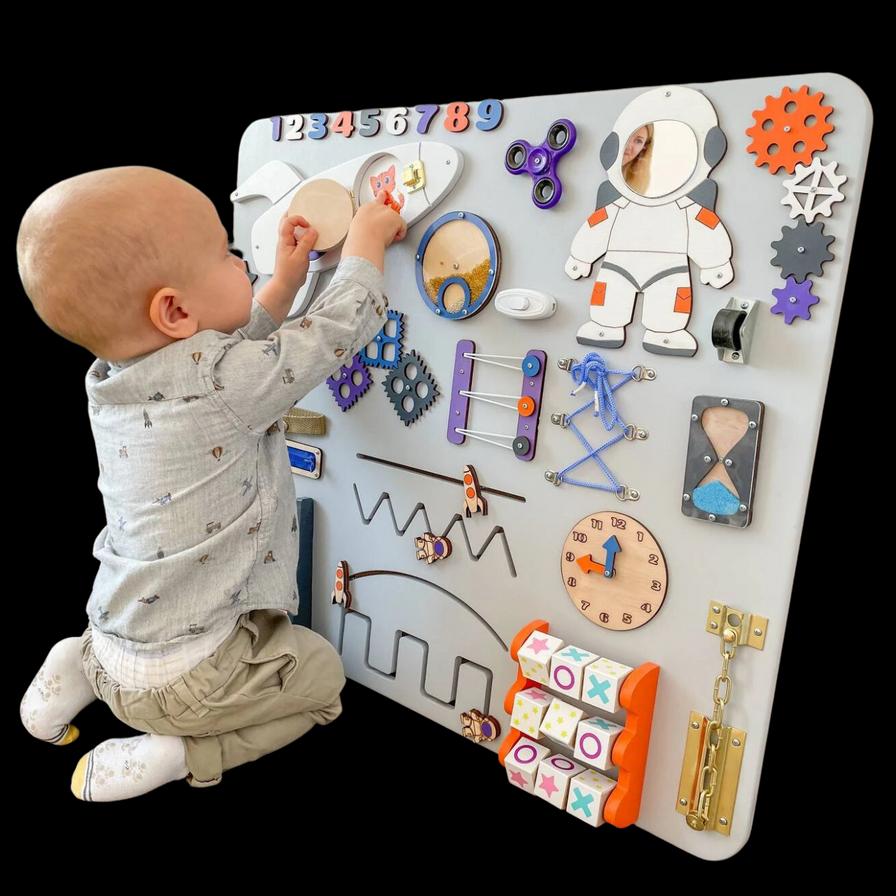
According to Marquet (2020), Sensory boards provide your youngster a secure space to handle many different items and textures In essence, they are made up of a strong basis to which numerous household goods are linked A natural component of a child's growth, sensory play is stimulated through sensory boards, which offer an organized manner to do so
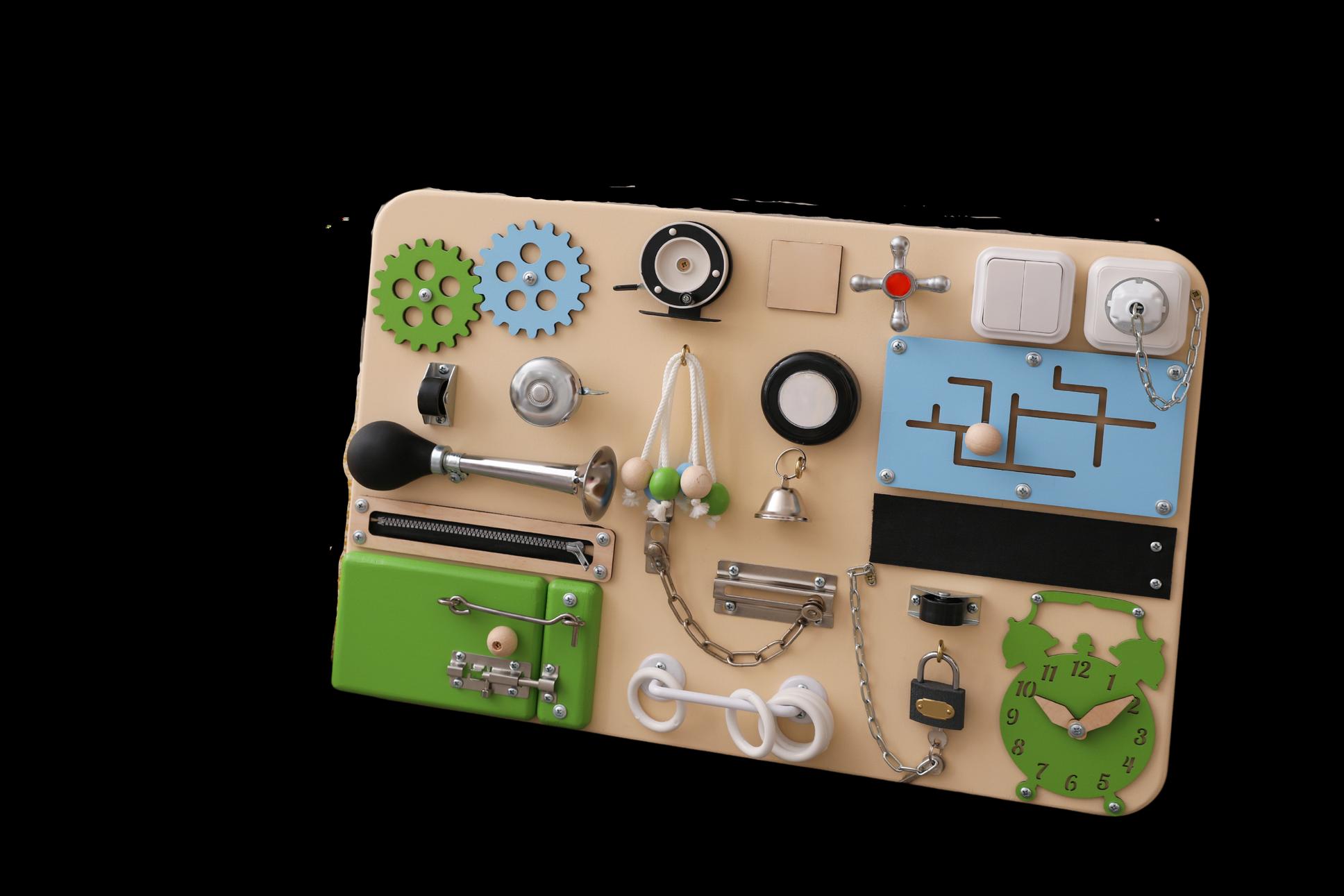
Busy board can be considered as a long-term investment as it enables the child to have holistic development and since sensory play is crucial for a child’s development, it is worth the investment. Variations and different materials can be combined to make and create your own sensory or busy boards that can cater the different sensory needs of your child. It’s important for children to satisfy their sensory needs and achieve multi-sensory experience in order to avoid internal conflict and confusion.
Sensory learning, cognitive growth, creative problem solving and enhancing fine motor skills are some of the many benefits and advantages that busy boards or sensory boards have to offer when it comes to a child’s early development. Additionally, every item on the board poses a different difficulty, aiding the child's development of problem-solving skills By customizing your own busy board, you can make the toy more meaningful and educational for your child (Busy Boards London, 2023).
Aids in problem solving and cognitive thinking development
Helps develop fine motor skills
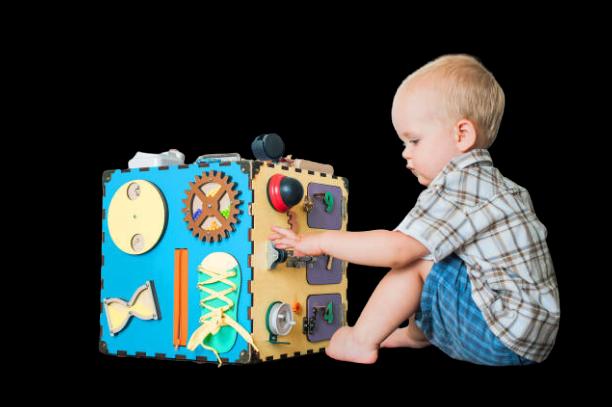
@bowlbysno1fan rates this product
PROMOTES
Exploration and learning
PURCHASED AT 50% OFF
My husband and I purchased the Montessori Busy Board for our twins' last website sale and it's all they've been playing with! It provides them with so many options, they're entertained for the whole evening. We're big fans of Bowlby's Attachment Theory and think this type of Montessori play was the best fit for our kids. Because of how repetitive and predictable the play is, they're able to sharpen their skills in tying their shoelaces or trying different solutions to the same problem. It also stimulates their sensory needs, so my husband and I don't need to keep making sensory bags or activities as much! Overall, this is a great product and we'd highly recommend it to any parent for their developing babies, toddlers, and kids!
Anh, L. P. (2023). Busy board - A must-have educational toy that helps develop young children’ fine motor skills. Melli’s Kids.
https://melliskids.au/blogs/news/best-busy-board-for-finemotor-development
Busy Boards London. (2023). Empowering Visually Impaired Children with Busy Boards and Sensory Play. Busy Boards London. https://busyboardslondon.com/empowering-visuallyimpaired-children-with-busy-boards123/#:~:text=Encouraging%20problem%2Dsolving%3A%20Each% 20object
Cerri, E. (2022, August 15). Montessori busy board: what it’s for, sensory activities and buying guide | Cherieswood. Cherieswood.
https://cherieswood.com/blog/montessori-busy-board-what-itsfor-sensory-activities-and-buying-guide/
Davies, S. (2023). What is the research into Montessori? And does Montessori work? The Montessori Notebook.
https://themontessorinotebook.com/does-montessori-work
Grusec, J. E. (1992). Social learning theory and developmental psychology: The legacies of Robert Sears and Albert Bandura. Developmental Psychology, 28(5), 776–786.
https://doi.org/10.1037/0012-1649.28.5.776
Hong, Y. J., & Park, J. Y. (2012). Impact of attachment, temperament and parenting on human development. Korean Journal of Pediatrics, 55(12), 449.
https://doi.org/10.3345/kjp.2012.55.12.449
Isaacs, B. (2018). Understanding the Montessori approach: Early years education in practice. https://hmk.am/wpcontent/uploads/2021/10/Understanding-the-MontessoriApproach -Early-Years-Education-in-Practice.pdf
MacDonald, M. (2022, November 14). The Benefits of Busy Boards - PakMag. PakMag. https://pakmag.com.au/the-benefits-of-busyboards/
Marquet, M. (2020). Sensory Boards For Toddlers: What Are They & Why They're Good. Moms. https://www.moms.com/sensoryboards-toddler-pro/
Mcleod, S., PhD. (2023). Vygotsky’s Sociocultural Theory of Cognitive Development. Simply Psychology.
https://www.simplypsychology.org/vygotsky.html Ministry of Education. (2021, March 25). Play idea: Manipulative play – Mahi ā-ringa Education in New Zealand
https://www.education.govt.nz/early-childhood/teaching-andlearning/learning-ideas/manipulativeplay/#:~:text=Manipulative%20play%20allows%20children%20to, also%20be%20a%20cooperative%20activity.
Nabavi, R. T., & Bijandi, M. S. (2012). Bandura’s Social Learning Theory & Social Cognitive Learning Theory. ResearchGate.
https://www.researchgate.net/publication/267750204 Bandura%2 7s Social Learning Theory Social Cognitive Learning Theory
NAEYC. (n.d.). Principles of Child Development and Learning and Implications That. https://www.naeyc.org/resources/positionstatements/dap/principles
Williams, D (2022) Child Development Theories: Lev Vygotsky First Discoverers. https://www.firstdiscoverers.co.uk/levvygotsky-child-developmenttheories/#:~:text=Vygotsky's%20sociocultural%20theory%20asser ts%20that,development%20of%20higher%20psychological%20fu nctions